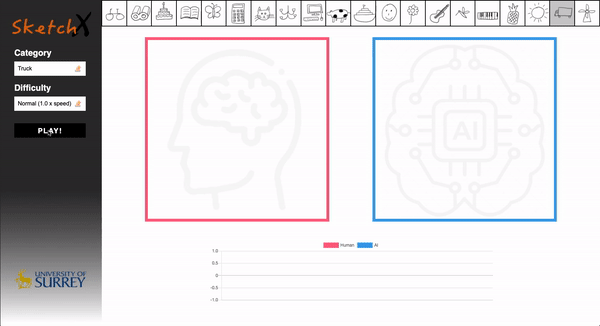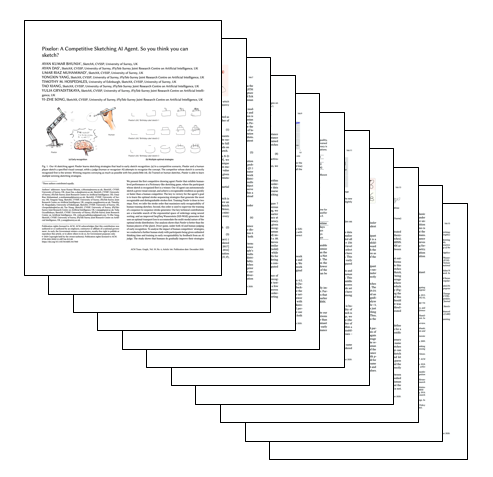Pixelor: A Competitive Sketching AI Agent. So you think you can sketch?
Ayan Kumar Bhunia* Ayan Das* Umar Riaz Muhammad*
Yongxin Yang Timothy M. Hospedales Tao Xiang Yulia Gryaditskaya Yi-Zhe Song
Published at SIGGRAPH Asia 2020


Please enjoy our game and have fun trying out our demo!
Short Presentation
[wonderplugin_video iframe=”https://www.youtube.com/watch?v=E_Aclms4g-w&feature=emb_logo” videowidth=600 videoheight=400 keepaspectratio=1 videocss=”position:relative;display:block;background-color:#000;overflow:hidden;max-width:100%;margin:0 auto;” playbutton=”http://sketchx.eecs.qmul.ac.uk/wp-content/plugins/wonderplugin-videoembed/engine/playvideo-64-64-0.png”]
Abstract
We present the first competitive drawing agent Pixelor that exhibits human-level performance at a Pictionary-like sketching game, where the participant whose sketch is recognized first is a winner. Our AI agent can autonomously sketch a given visual concept, and achieve a recognizable rendition as quickly or faster than a human competitor. The key to victory for the agent’s goal is to learn the optimal stroke sequencing strategies that generate the most recognizable and distinguishable strokes first. Training Pixelor is done in two steps. First, we infer the stroke order that maximizes early recognizability of human training sketches. Second, this order is used to supervise the training of a sequence-to-sequence stroke generator. Our key technical contributions are a tractable search of the exponential space of orderings using neural sorting; and an improved Seq2Seq Wasserstein (S2S-WAE) generator that uses an optimal-transport loss to accommodate the multi-modal nature of the optimal stroke distribution. Our analysis shows that Pixelor is better than the human players of the Quick, Draw! game, under both AI and human judging of early recognition. To analyze the impact of human competitors’ strategies, we conducted a further human study with participants being given unlimited thinking time and training in early recognizability by feedback from an AI judge. The study shows that humans do gradually improve their strategies with training, but overall Pixelor still matches human performance.
Method Overview

A schematic illustration of the two step setting to train our stroke rendering agent – Pixelor. Yellow: Neural sort prediction for stroke-level order which maximizes sketch recognition for the accumulated stroke representation. Red: Supervised training of Seq2Seq-WAE. We use Maximum Mean Discrepancy (MMD) as a divergence measure between two distributions.
Paper and Bibtex

@inproceedings{bhunia2020sketch, title={Pixelor: A Competitive Sketching AI Agent. So you think you can beat me?}, author={Bhunia, Ayan Kumar and Das, Ayan and Riaz Muhammad, Umar and Yang, Yongxin and Hospedales, Timothy M. and Xiang, Tao and Gryaditskaya, Yulia and Song, Yi-Zhe}, booktitle={SIGGRAPH Asia}, year={2020} }